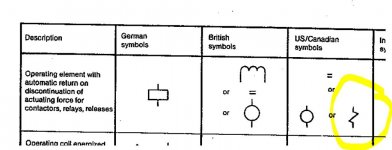alphonso
Titanium
- Joined
- Feb 15, 2006
- Location
- Republic of Texas
Schematic for machine in https://www.practicalmachinist.com/...ment-cant-rem-eber-what-device-called-389989/
I can't seem to find a definite definition for the zig-zag line symbol in several places.
For instance, the drive motor start circuit, lower middle left, shows this zig-zag symbol to the left of the L6 pilot light. What the hell does this signify?

I can't seem to find a definite definition for the zig-zag line symbol in several places.
For instance, the drive motor start circuit, lower middle left, shows this zig-zag symbol to the left of the L6 pilot light. What the hell does this signify?








